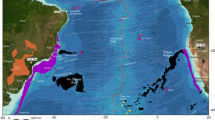Abstract
THE volcanic islands of the Galapagos archipelago are the most recent products of a long-lived mantle hotspot1,2. Little is known, however, of the submarine Galapagos platform on which the islands are built, or of the Cocos and Carnegie submarine ridges produced by past motion of the Cocos and Nazca plates across the hotspot3,4. In 1990 we surveyed selected areas around the Galapagos platform and as far east as 85°30' W on the Carnegie ridge, where we dredged abundant well-rounded basalt cobbles from a small sea-mount with a terraced summit region. Cobbles were also dredged from several other seamounts. We interpret these features, especially the presence of cobbles, as evidence for erosion near sea level and conclude that these seamounts were volcanic islands before subsiding to their present depths. Radiometric ages for these drowned islands range from 5 to 9Myr, consistent with predicted plate motions. They indicate that the time available for speciation of Galapagos organisms is much longer than the age range of the existing islands.
Similar content being viewed by others
References
Morgan, W. J. Nature 230, 42–43 (1971).
Morgan, W. J. Am. Assoc. Petrol. Geol. Bull. 56, 203–213 (1972).
Hey, R. N. Geol. Soc. Am. Bull. 88, 1404–1420 (1977).
Cox, A. in Patterns of Evolution in Galapagos Organisms (eds Bowman, R. I. & Leviton, A. E.) 11–23 (American Association for the Advancement of Science, Washington DC, 1983).
Malfait, B. T. thesis, Oregon State Univ. (1975).
Geist, D. J., McBimey, A. R. & Duncan, R. A. Geol. Soc. Am. Bull. 97, 555–566 (1986).
Baitis, H. W. & Swanson, F. J. Nature 259, 195–197 (1976).
Dalrymple, G. B., Lanphere, M. A. & Clague, D. A. in Init. Rep. Deep-Sea Drilling Project 55 (eds Jackson. E. D. et al.) 659–676 (US Government Printing Office, Washington, 1981).
O'Connor, J. M. & Duncan, R. A. J. geophys. Res. 95, 17475–17502 (1990).
Duncan, R. A. & Clague, D. A. in The Ocean Basins and Margins 7 A (eds Nairn, A. E. M., Stehli, F. G. & Uyeda. S.) 89–121 (Plenum. New York. 1985).
Minster, J. B. & Jordan, T. H. J. geophys. Res. 83, 5331–5354 (1978).
Gripp, A. E. & Gordon, R. G. Geophys. Res. Lett. 17, 1109–1112 (1990).
Duncan, R. A. & Hargraves, R. B. in The Caribbean-South American Plate Boundary and Regional Tectonics, Geol. Soc. Am. Mem. 162 (eds Bonini, W. E., Hargraves, R. B. & Shagam, R.) 81–94 (1985).
Hickman, C. S. & Lipps, J. H. Science 227, 1578–1580 (1985).
Wiles, J. S. & Sarich, V. M. in Patterns of Evolution in Galapagos Organisms (eds Bowman, R. I. & Leviton, A. E.) 177–186 (American Association for the Advancement of Science, Washington DC, 1983).
Sen, G., Hickey-Vargas, R., Waggoner, D. G. & Maurasse, F. Earth planet. Sci. Lett 87, 423–437 (1988).
Author information
Authors and Affiliations
Rights and permissions
About this article
Cite this article
Christie, D., Duncan, R., McBirney, A. et al. Drowned islands downstream from the Galapagos hotspot imply extended speciation times. Nature 355, 246–248 (1992). https://doi.org/10.1038/355246a0
Received:
Accepted:
Issue Date:
DOI: https://doi.org/10.1038/355246a0
- Springer Nature Limited
This article is cited by
-
Characterization of deep-sea benthic invertebrate megafauna of the Galapagos Islands
Scientific Reports (2020)
-
A hitchhikers guide to the Galápagos: co-phylogeography of Galápagos mockingbirds and their parasites
BMC Evolutionary Biology (2011)
-
The Influence of Historical Geneflow, Bathymetry and Distribution Patterns on the Population Genetics of Morphologically Diverse Galápagos’ Opuntia echios
Journal of Molecular Evolution (2011)
-
Why Darwin rejected intelligent design
Journal of Biosciences (2009)
-
Phylogeography of California and Galápagos sea lions and population structure within the California sea lion
Marine Biology (2009)





